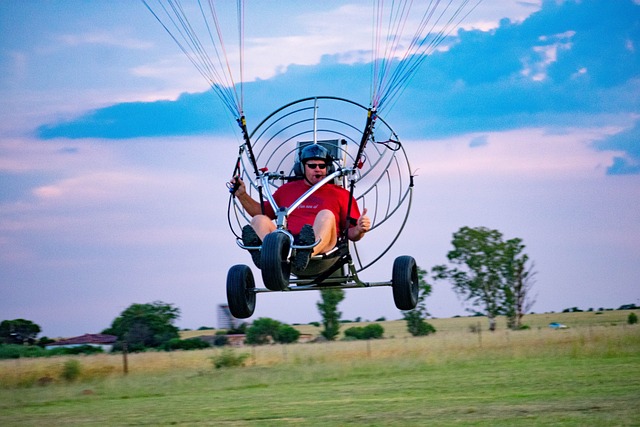Paramotors are unique types of aircraft that can be launched and flown with a motor and a paraglider. These machines are becoming increasingly popular due to their versatility, affordability, and ease of use. One critical aspect of owning a paramotor is ensuring that it has the appropriate fuel tank capacity. Without enough fuel, a paramotor flight can be short-lived and even dangerous.
Paramotor fuel tank capacity refers to the amount of fuel that a paramotor fuel tank can hold and is an important factor to consider when choosing a paramotor and planning a flight, as it affects flight time and distance. Common fuel tank capacities for paramotors range from 3 to 25 liters, and it’s essential to maintain the fuel tank regularly to ensure optimal performance and longevity.
In this guide, I will discuss how to choose the right fuel tank capacity for your paramotor and the common fuel tank capacities available in the market. I will also cover tips on maintaining your paramotor fuel tank to ensure optimal performance and longevity.
How to Choose the Right Fuel Tank Capacity
Choosing the right fuel tank capacity for your paramotor can be a crucial decision that can impact the duration and distance of your flights. Here are 3 factors to consider when selecting the appropriate fuel tank capacity:
- Flight Time: The length of your flight is the most crucial factor to consider when selecting a fuel tank capacity. If you plan to fly for an extended period, you will need a larger fuel tank. Consider how long you want to fly and choose a tank that can hold enough fuel to last the entire flight.
- Distance of Flight: The distance you plan to travel also plays a significant role in selecting the right fuel tank capacity. If you intend to travel a long distance, you will need a larger tank that can hold enough fuel to reach your destination.
- Fuel Efficiency: Fuel efficiency is also a critical factor in selecting a fuel tank capacity. Different paramotors have different fuel efficiency levels, so you need to choose a tank that matches your paramotor’s fuel consumption rate.
Once you have considered these factors, you can calculate the required fuel tank capacity for your paramotor. To do this, you can use a fuel consumption calculator or consult with an expert in paramotor fuel tanks. Remember to choose a tank that provides enough fuel for your specific needs, and avoid tanks that are too large and heavy for your paramotor.
Common Fuel Tank Capacities for Paramotors
There are several common fuel tank capacities available in the market for paramotors. These capacities can vary depending on the brand, model, and design of the paramotor. Below are 4 of the most common fuel tank capacities for paramotors:
- 3-liter capacity: This is the smallest fuel tank capacity available in the market for paramotors. It is suitable for short flights or for beginners who are learning how to fly a paramotor.
- 10-liter capacity: This is a mid-range fuel tank capacity that can provide enough fuel for longer flights. It is a popular choice among paramotor pilots who want a balance between flight time and weight.
- 15-liter capacity: This fuel tank capacity can provide enough fuel for flights that last for several hours. It is a popular choice for paramotor pilots who want to fly long distances.
- 25-liter capacity: This is the largest fuel tank capacity available in the market for paramotors. It can provide enough fuel for flights that last for several hours or even an entire day. It is a popular choice for paramotor pilots who want to fly long distances without having to refuel.
Each fuel tank capacity has its own set of advantages and disadvantages, so it’s important to choose the one that best suits your needs. For instance, a larger fuel tank capacity can provide more flight time, but it can also add more weight to your paramotor. On the other hand, a smaller fuel tank capacity can be lighter, but it may limit your flight time.
Maintaining Your Paramotor Fuel Tank
Maintaining your paramotor fuel tank is essential to ensure that it performs optimally and lasts for a long time. Here are 4 tips on how to maintain your paramotor fuel tank:
- Regular Checks: Regularly inspect your fuel tank for any signs of damage, leaks, or corrosion. Check the tank’s fittings, hoses, and connections for any wear and tear. Address any issues promptly to avoid further damage.
- Cleaning the Tank: It’s essential to keep your fuel tank clean to prevent contaminants from entering the engine. Use a fuel tank cleaner to remove any debris or residue that may have accumulated in the tank. Make sure to follow the manufacturer’s instructions when cleaning your tank.
- Replacing Worn-Out Parts: Over time, parts of your fuel tank may wear out or become damaged. Replace any worn-out parts, such as the fuel cap, hoses, or fittings, to ensure that your tank operates properly.
- Storing Your Paramotor: If you plan to store your paramotor for an extended period, it’s essential to drain the fuel tank and fuel lines to prevent corrosion and contamination. You can also use a fuel stabilizer to prevent the fuel from degrading over time.
Remember to always refer to the manufacturer’s instructions when performing maintenance on your paramotor fuel tank.
Conclusion
In conclusion, selecting the right fuel tank capacity for your paramotor is crucial to ensure that you have a safe and enjoyable flight. Consider factors such as flight time, the distance of the flight, and fuel efficiency when choosing a fuel tank capacity. Common fuel tank capacities for paramotors include 3 liters, 10 liters, 15 liters, and 25 liters, each with its own set of advantages and disadvantages.
It’s also essential to maintain your paramotor fuel tank regularly by performing checks, cleaning the tank, replacing worn-out parts, and storing the paramotor correctly. By following these tips, you can ensure that your paramotor fuel tank performs optimally and lasts for a long time.








